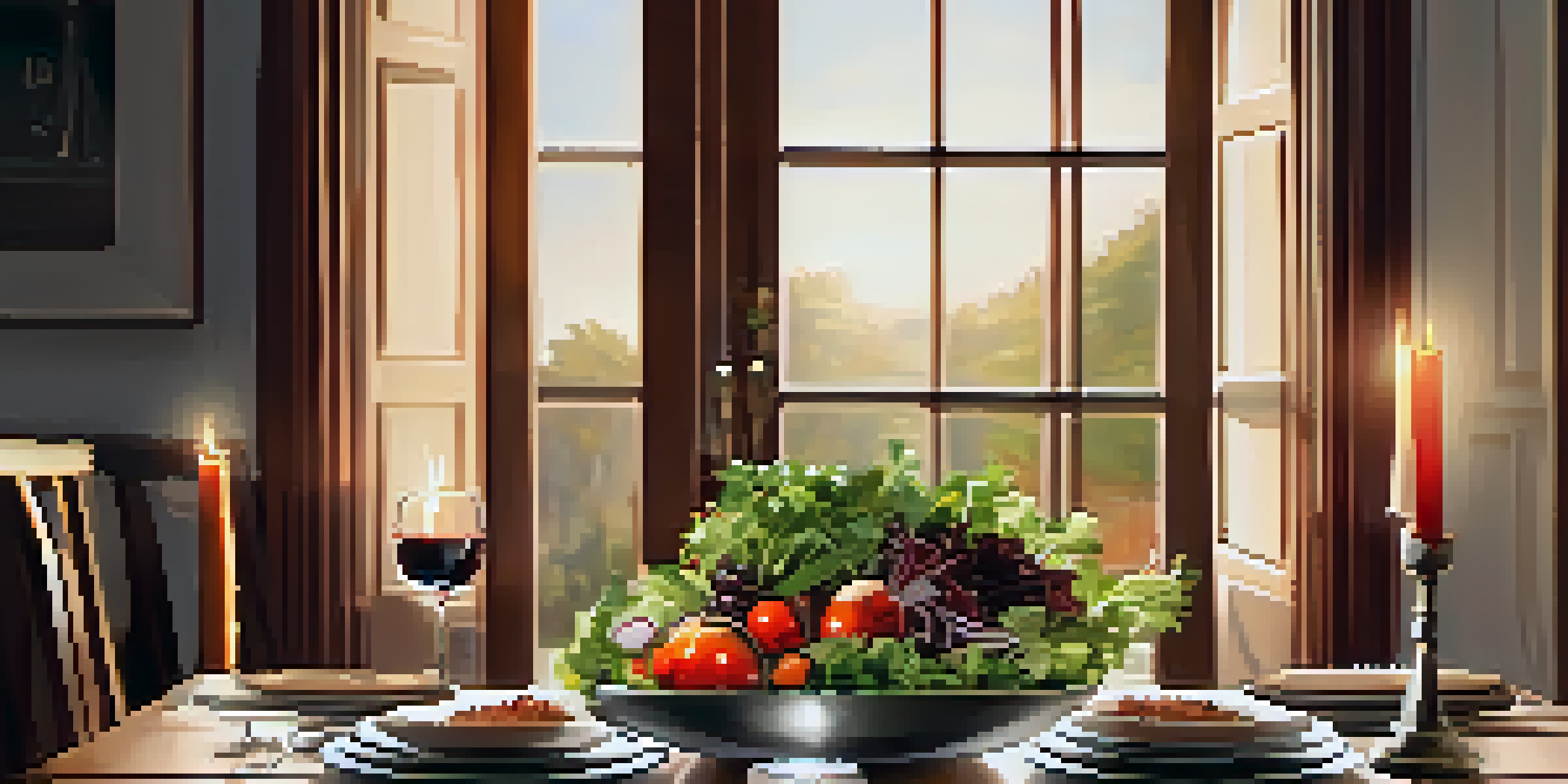The Impact of Lighting on Food Presentation and Enjoyment

Understanding the Role of Lighting in Dining Spaces
Lighting sets the mood in any dining environment, influencing how food is perceived. Soft, warm lights create a cozy atmosphere, making meals feel more inviting. In contrast, bright, harsh lighting can detract from the culinary experience, making dishes appear less appealing.
Good food is a celebration of life; good lighting is the icing on the cake.
Think about your favorite restaurant: the ambiance is often created by the lighting. It's not just about visibility; it's about creating an experience that enhances the flavor and presentation of the food. When you walk into a space with the right lighting, it feels like you're stepping into a different world, one that celebrates gastronomy.
Overall, the right lighting can transform a meal into an experience, enhancing everything from the colors of the dish to the emotional response of the diners. This is why restaurants invest heavily in lighting design, understanding its importance in food presentation.
The Psychology of Color and Light in Food Presentation
Colors play a significant role in how we perceive food, and lighting can enhance or mute these colors. For instance, warm lighting can make reds and yellows pop, making dishes appear more appetizing. This interplay between color and light is crucial in food photography and presentation.

Picture a vibrant salad under bright, white light; it may look fresh and crisp, but under soft, warm light, the greens and reds can appear more lush and inviting. This psychological effect means that how food is lit can change our perception of flavor and freshness, impacting our overall enjoyment.
Lighting Shapes Dining Experiences
The right lighting can transform a meal into an immersive experience, enhancing both the presentation and enjoyment of food.
In essence, the right color temperature in lighting can complement the colors of the food, creating a more harmonious and appealing dining experience. This is why chefs and food stylists often consider lighting when preparing dishes for photography or presentation.
How Lighting Affects Our Appetite and Dining Experience
Lighting can influence our appetite and the overall dining experience in subtle yet significant ways. Research suggests that softer lighting can lead to longer meal durations, encouraging diners to savor their food. In contrast, overly bright environments can make people rush through their meals.
Lighting is an essential part of the dining experience, creating ambiance and influencing how we perceive food.
Imagine dining in a candle-lit restaurant versus a brightly lit fast-food joint. The former encourages relaxation and enjoyment, while the latter often promotes a quick, functional eating experience. This difference in lighting not only affects our mood but also our relationship with food.
By creating an environment that encourages diners to linger, restaurants can enhance the overall enjoyment of the meal and increase the likelihood of return visits. Thus, the impact of lighting extends beyond aesthetics; it plays a crucial role in shaping our dining habits.
The Influence of Natural Light on Food Perception
Natural light is often considered the gold standard in food presentation. It showcases the true colors and textures of food, making everything look fresher and more vibrant. This is why many cafes and restaurants strive for large windows and outdoor seating options.
Consider a brunch spot with ample sunlight streaming in; the natural light enhances the golden hue of pancakes and the vibrant colors of fresh fruits. This not only makes the food more visually appealing but can also elevate the overall mood of the diners.
Natural Light is Ideal for Food
Natural light showcases true colors and textures, making dishes appear fresher and more vibrant.
Additionally, dining in natural light can have a positive psychological impact, making the experience feel more relaxed and enjoyable. This connection between natural light and food perception is why many chefs prefer to serve their dishes in daylight whenever possible.
Creating the Perfect Lighting for Different Cuisines
Different cuisines can benefit from different lighting styles. For example, Mediterranean dishes often look best under warm, soft lighting that accentuates their rich colors and textures. On the other hand, Asian cuisines may be beautifully presented under cooler light, enhancing the intricate details and freshness of the ingredients.
Imagine enjoying a plate of vibrant sushi; under cooler lighting, the fresh fish and colorful vegetables can appear even more lively and appetizing. This tailoring of lighting to cuisine type can deeply impact diners' perceptions and enjoyment.
Ultimately, understanding how lighting interacts with various cuisines allows chefs and restaurateurs to craft a dining experience that highlights the best aspects of each dish. This attention to detail can set a restaurant apart in a competitive culinary landscape.
The Role of Lighting in Food Photography and Marketing
In today's digital age, food photography plays a crucial role in marketing. The right lighting can make food look irresistible, drawing in customers through social media and advertising. Photographers often use natural and controlled lighting to capture the best aspects of a dish.
For instance, a well-lit photo showcasing a decadent dessert can evoke feelings of indulgence and desire. The interplay of shadows and highlights can create depth and dimension, making the food appear almost three-dimensional.
Tailored Lighting Enhances Cuisines
Different cuisines benefit from specific lighting styles that highlight their unique colors and textures for a better dining experience.
This emphasis on lighting in food photography not only influences consumers' choices but also shapes how restaurants present their offerings online. The importance of lighting in marketing cannot be underestimated, as it directly impacts consumer engagement and decision-making.
Tips for Home Chefs: Lighting Your Culinary Creations
Home cooks can also benefit from understanding the impact of lighting on food presentation. A well-lit kitchen can enhance the cooking experience, while strategic lighting during mealtime can elevate the dining atmosphere. Consider using soft, warm lights to create a comforting dining experience at home.
When plating your dishes, try to position them near natural light sources or use warm bulbs to capture the colors beautifully. This simple adjustment can make even the simplest meals look gourmet, impressing family and friends alike.

Ultimately, lighting is an easy yet often overlooked aspect of home cooking that can enhance not just presentation but also the overall enjoyment of meals shared with loved ones.